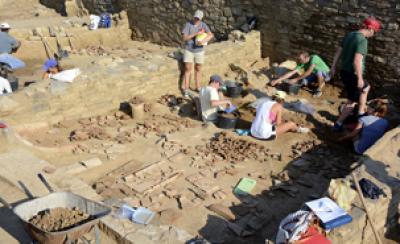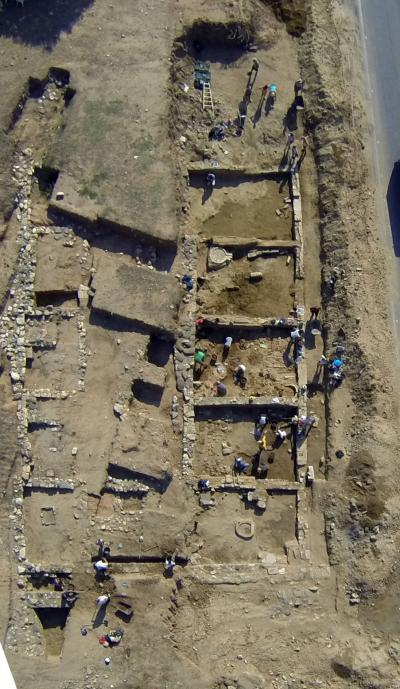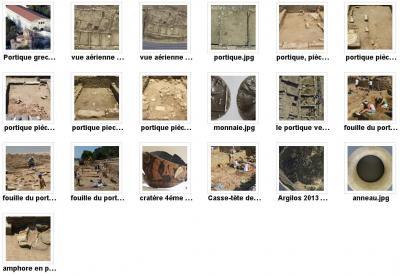A 2,700-year-old portico was discovered this summer on the site of the ancient city of Argilos in northern Greece, following an archaeological excavation led by Jacques Perreault, Professor at the University of Montreal's Centre of Classical Studies and Zisis Bonias, an archaeologist with the Hellenic Ministry of Culture and Sports.
In ancient Greece, the portico—stoa in Greek—was a long, open structure that often housed shops and delineated public squares from the city—the agora.
"Porticos are well known from the Hellenistic period, from the 3rd to 1st century BC, but earlier examples are extremely rare. The one from Argilos is the oldest example to date from northern Greece and is truly unique," said Jacques Perreault, who is a specialist of the Greek Archaic period (7th and 6th centuries BC.)
Located on the edge of the Aegean Sea, the ancient city of Argilos was the first Greek colony established in this area around the great Strymon River. At its peak in the 5th century BC, Argilos was one of the richest cities in the region.
Since 1992, Professor Perreault and Dr Bonias have excavated the hill covering Argilos and the University of Montreal has acquired some of the private land sitting on it. Acquisitions were made on behalf of the Greek government, but the excavators retain the rights over scientific research. The remains of the Argilos portico are located on one of these sites, at the northern end of what was the city's commercial district, 50 metres from the port area at the time.

Practicum students try to piece back together the multiple tile fragments that covered the floor of this shop in the Argilos portico.
(Photo Credit: Photo: Jacques Perreault, Université de Montréal)
Traces of the inhabitants' entrepreneurship
Archaelogical digs in 2013 unearthed a roughly 40-metre length of the portico. The open area once contained seven rooms, five of which have been excavated, each measuring 5 metres wide and 7.5 metres deep, with a 2.5-metre high back wall.
Since Argilos was prosperous, it is plausible that the portico was commissioned and built by the city. If this were the case, an architect would have overseen the construction and architectural integrity of the structure; there would have been no differences in the size of the stones used, and all the rooms would have been identical.
However, examination of the remains indicates just the contrary.
"The construction techniques and the stones used are different for one room to another, hinting that several masons were used for each room," Perreault said. "This indicates that the shop owners themselves were probably responsible for building the rooms, that 'private enterprise' and not the city was the source of this stoa."

This is an aerial photo of the portico discovered by the team of Jacques Perreault. Based on electrical resistivity tests, the structure continues for several meters. The picture was taken from a camera attached to a mini-unmanned quadcopter.
(Photo Credit: Jacques Perreault, Université de Montréal)
A prosperous city falls into oblivion
In the Iron Age, northern Greece was an Eldorado. The valley of the Strymon River, whose mouth is located less than three kilometres from Argilos, overflowed with gold and silver mines.
With its ports and nearby mines, Argilos was a strategic location for trade in precious metals.
But its prosperity declined rapidly from the mid-5th century BC, when the Athenians founded the nearby city of Amphipolis. In 357 BC, Philip II conquered the whole region and deported the inhabitants from Argilos to Amphipolis, the new seat of the king of Macedonia.
Thus deserted, Argilos remained frozen in time, which is why it is possible today to discover its buildings and the many vestiges of human activity that characterized them.
A popular practicum location
Since it has been under the responsibility of Perreault and Bonias, the Argilos site has provided a practicum location for some 450 University of Montreal students under their supervision.
"Each year, 20 to 30 students spend four to six weeks at Argilos to learn excavation techniques and analysis of archaeological material, and to visit various archaeological sites in northern Greece," says Perreault.
And the experience is far from over. The portico itself has not yet been fully excavated, and according to the results of a three-metre deep geophysical survey, the structure appears to continue, and more discoveries thus await the archaeologists.

A 2,700-year-old portico was discovered this summer on the site of the ancient city of Argilos in northern Greece, following an archaeological excavation led by Jacques Perreault, Professor at the University of Montreal's Centre of Classical Studies and Zisis Bonias, an archaeologist with the Hellenic Ministry of Culture and Sports. Selection of images available in high resolution upon request.
(Photo Credit: Jacques Perreault, Université de Montréal.)
Source: University of Montreal